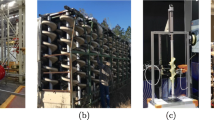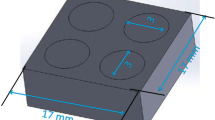Abstract
The manufacturing sector is experiencing a transformation to Industry 4.0. The authors are researching 3D printable sensors to measure operating conditions like wear, strain and temperature, as part of a project to develop a large-scale multi-material extrusion 3D printer to print a Gravity Separation Spiral—a piece of mining equipment that separates minerals from slurry. This paper proposes a sensor placement methodology for placing embedded sensors in large 3D printed objects. Voxels, the 3D equivalent of 2D pixels, are used to discretise the object and an optimisation routine optimally positions the 3D printable sensors into a 3D printed object. The optimisation objectives that are used during sensor placement include the information gain from the sensor, the ability to print the sensor using a robot, and the ability to discourage sensors being placed in important structural locations by penalising these voxels. Finite element analysis is employed to measure the information gain, while the robot arm’s manipulability measures the capability to print at each voxel location. The objectives are integrated using 3D kernels, which are represented by voxels shaped in the size of the sensor and different weights related to the intricate traces that need to be printed. Using a weighted objective function the best locations are chosen. A simulation environment has been developed to simulate the printing and Matlab is used to do the voxel-based calculations to identify the ideal location for sensor placement.











Similar content being viewed by others
References
Addinsoft (2021). “Electre Methods”. https://www.xlstat.com/en/solutions/features/multicriteria-decision-aid-electre-methods
Behzadian, M., Kazemzadeh, R. B., Albadvi, A., & Aghdasi, M. (2010). PROMETHEE: A comprehensive literature review on methodologies and applications. European Journal of Operational Research, 200(1), 198–215.
Bougdid, Y., & Sekkat, Z. (2020). Voxels optimization in 3D laser nanoprinting. Scientific Reports, 10(1), 10409.
Corke, P. (2015). Robotics vision and control (2nd ed.). Springer.
Engineers Australia (2019). Milestone for mining manufacture with 3D printing. https://portal.engineersaustralia.org.au/news/milestone-mining-manufacture-3d-printing
Fidanova, S., Marinov, P., & Alba, E. (2012). Ant algorithm for optimal sensor deployment. In Computational intelligence (pp. 21–29). Springer.
Fuqing, L., & Lingmi, Z. (2000). Successive method for optimal placement of actuators and sensors. Journal of Astronautics, 3(21), 64–69.
Guratzsch, R. F., & Mahadevan, S. (2010). Structural health monitoring sensor placement optimization under uncertainty. American Institute of Aeronautics and Astronautics Journal, 48(7), 1281–1289.
Hwang, H., Bae, J. H., & Min, B. C. (2017). Design guidelines for sensor locations on 3D printed prosthetic hands. In IEEE international conference on robotic computing (pp. 412–417).
IMCRC (2018). Innovative Manufacturing CRC Annual Highlights 2017–2018. Technical Report.
ISO/ASTM 52900 (2015). Technical Report.
Jiang, J., Xu, X., Xiong, Y., Tang, Y., Dong, G., & Kim, S. (2020). A novel strategy for multi-part production in additive manufacturing. The International Journal of Advanced Manufacturing Technology, 109(5), 1237–1248.
Jung, J. H., Shin, Y., & Kwon, Y. (2018). Extension of convolutional neural network with general image processing kernels. In IEEE region 10 conference (pp. 1436–1439).
Kammer, D. (1990). Sensor placement for on-orbit modal identification and correlation of large space structures. In IEEE American control conference (Vol. 1, pp. 2984–2990).
Lavín-Delgado, J. E., Solís-Pérez, J. E., Gómez-Aguilar, J. F., & Escobar-Jiménez, R. F. (2020). A new fractional-order mask for image edge detection based on Caputo-Fabrizio fractional-order derivative without singular kernel. Circuits, Systems, and Signal Processing, 39(3), 1419–1448.
Makwe, A., & Kanungo, P. (2015). Scheduling in cloud computing environment using analytic hierarchy process model. In International conference on computer, communication and control (pp. 1–4).
Meo, M., & Zumpano, G. (2005). On the optimal sensor placement techniques for a bridge structure. Engineering Structures, 27(10), 1488–1497.
Munasinghe, N., & Paul, G. (2020a). Integrated 3-D printable temperature sensor for advanced manufacturing. In Australasian conference on robotics and automation.
Munasinghe, N., & Paul, G. (2020b). Path planning for robot based radial advanced manufacturing using print space sampling. In International conference on control, automation, robotics and vision.
Munasinghe, N., Masangkay, J., & Paul, G. (2021). Temperature compensated 3D printed strain sensor for advanced manufacturing applications. In IEEE international conference on robotics and automation.
Munasinghe, M. I. N. P., Miles, L., & Paul, G. (2019). Direct-write fabrication of wear profiling IoT sensor for 3D printed industrial equipment. In International symposium on automation and robotics in construction (pp. 862–869).
Munasinghe, N., & Paul, G. (2020). Radial slicing for helical-shaped advanced manufacturing applications. The International Journal of Advanced Manufacturing Technology, 112(3–4), 1089–1100.
Munasinghe, N., Woods, M., Miles, L., & Paul, G. (2019). 3-D printed strain sensor for structural health monitoring. In IEEE international conference on cybernetics and intelligent systems and the international conference on robotics, automation and mechatronics.
Ostachowicz, W., Soman, R., & Malinowski, P. (2019). Optimization of sensor placement for structural health monitoring: a review. Structural Health Monitoring, 18(3), 963–988.
Papadimitriou, C. (2005). Pareto optimal sensor locations for structural identification. Computer Methods in Applied Mechanics and Engineering, 194(12–16), 1655–1673.
Papadimitriou, C., & Lombaert, G. (2012). The effect of prediction error correlation on optimal sensor placement in structural dynamics. Mechanical Systems and Signal Processing, 28, 105–127.
Paul, G., Liu, L., & Liu, D. (2016). A novel approach to steel rivet detection in poorly illuminated steel structural environments. In International conference on control, automation, robotics and vision (pp. 1–7).
Rahmat, K. B., Dharma, D., & Manaf, A. (2019). Rendering speed improvement for particle based fluid simulation on GVDB voxels using whitted raytracing. In International conference on data and software engineering (pp. 1–6).
Rao, A. R. M., & Anandakumar, G. (2007). Optimal placement of sensors for structural system identification and health monitoring using a hybrid swarm intelligence technique. Smart Materials and Structures, 16(6), 2658.
Sohn, H., Farrar, C. R., Hemez, F., & Czarnecki, J. (2001). A review of structural health monitoring literature. In Library.Lanl.Gov (pp. 1–7).
Tan, Y., & Zhang, L. (2019). Computational methodologies for optimal sensor placement in structural health monitoring: A review. Structural Health Monitoring, 19(4), 1287–1308.
Wijaya, W., Ali, M., Umer, R., Khan, K., Kelly, P., & Bickerton, S. (2019). An automatic methodology to CT-scans of 2D woven textile fabrics to structured finite element and voxel meshes. Composites Part A: Applied Science and Manufacturing, 125, 105561.
Wong, K. V., & Hernandez, A. (2012). A review of additive manufacturing. ISRN Mechanical Engineering, 2012(208760), 10.
Wu, D., Coatanea, E., & Wang, G. G. (2019). Employing knowledge on causal relationship to assist multidisciplinary design optimization. Journal of Mechanical Design, 141(4), 041402.
Yi, T. H., & Li, H. N. (2012). Methodology developments in sensor placement for health monitoring of civil infrastructures. International Journal of Distributed Sensor Networks, 8(8), 612726.
Yi, T.-H., Li, H.-N., & Gu, M. (2011). A new method for optimal selection of sensor location on a high-rise building using simplified finite element model. Structural Engineering and Mechanics, 37(6), 671–684.
Yoshikawa, T. (1985). Manipulability and redundancy control of robotic mechanisms. In IEEE international conference on robotics and automation (Vol. 2, pp. 1004–1009).
Zohdi, T. I. (2019). Rapid voxel-based digital-computation for complex microstructured media. Archives of Computational Methods in Engineering, 26(5), 1379–1394.
Acknowledgements
This research is supported by UTS, The Commonwealth of Australia’s Department of Industry, Innovation and Science (Innovative Manufacturing CRC Ltd) and Downer, via its subsidiary Mineral Technologies. Thank you to Rapido, in particular, Hervé Harvard and Michael Behrens for establishing this overall research activity and leading the overall R&D engineering project. Authors acknowledge that Jordan Henry created the simulation environment of the printer according to the actual dimensions. Thank you to UTS:RI/CAS for providing the required resources to carry out this research.
Funding
This research is supported by UTS, The Commonwealth of Australiaś Department of Industry, Innovation and Science (Innovative Manufacturing CRC Ltd) and Downer, via its subsidiary Mineral Technologies.
Author information
Authors and Affiliations
Corresponding author
Ethics declarations
Conflict of interest
Not Applicable.
Availability of data and material
Not Applicable.
Code availability
Not Applicable.
Additional information
Publisher's Note
Springer Nature remains neutral with regard to jurisdictional claims in published maps and institutional affiliations.
This research is supported by UTS, in particular, Rapido; The Commonwealth of Australia’s Department of Industry, Innovation and Science (Innovative Manufacturing CRC Ltd); and Downer, via its subsidiary Mineral Technologies.
Rights and permissions
About this article
Cite this article
Munasinghe, N., Romeijn, T. & Paul, G. Voxel-based sensor placement for additive manufacturing applications. J Intell Manuf 34, 739–751 (2023). https://doi.org/10.1007/s10845-021-01823-x
Received:
Accepted:
Published:
Issue Date:
DOI: https://doi.org/10.1007/s10845-021-01823-x




